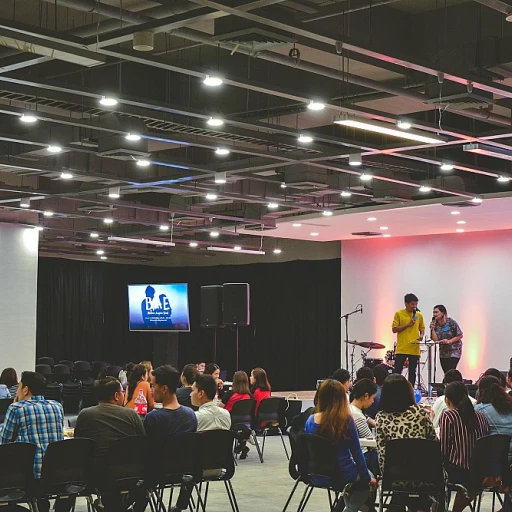Understanding Evolved HR
The Shift Towards a People-Centric Approach
The realm of human resources has been evolving steadily, becoming more people-centric than ever before. This transformation is largely driven by the need for businesses to align their talent management strategies with broader organizational goals. No longer seen purely as a back-office function, modern HR practices are now placing immense emphasis on strategic partnerships within the organization. This approach ensures that human resources, as a discipline, is integrated across all business facets.
Modern companies recognize the importance of nurturing talent and are reconfiguring their processes to support this ambition. With a focus on enhancing employee engagement and fostering a strong company culture, organizations aim to build environments where employees can thrive. More than just talent acquisition, these evolved practices take into account employee retention and performance management, which become key priorities under this new lens.
Leveraging Strategic Resources and Services
As companies continue to face the challenges of a dynamic business landscape, they are prompted to adopt data-driven strategies to manage their resources effectively. These strategies, supported by advanced resource management solutions, enable businesses to keep up with the ever-changing demands of the modern workforce.
Strategic talent management, therefore, becomes a focal point in ensuring an organization's competitiveness and longevity. Businesses, particularly in the United States, are now seeking to utilize resource services that bolster their human capital. This involves not only attracting the right talent but also promoting a culture of continuous learning and development.
Ensuring Human Emotion and Corporate Success
A company’s leadership is deeply vested in creating an inclusive and equitable workplace that resonates with human emotion and empathy. Understanding the nuanced needs of employees allows companies to craft tailored solutions aimed at boosting morale and productivity.
Moreover, reinforcing a privacy policy that aligns with employee expectations provides a sense of security and trust. By viewing human resources as both a strategic business partner and a support mechanism, organizations are better prepared to navigate the intricacies of an evolved HR landscape.
For further understanding of these evolved HR principles, readers can explore more about the essentials of human resource management.
The Role of Technology in Talent Management
Leveraging Advanced Technology for Future-Ready HR
In the rapidly evolving field of human resources, technology has become a critical component in streamlining talent management. As companies strive to enhance employee performance and retention, adopting data-driven strategies is more important than ever. Businesses are increasingly relying on digital solutions to optimize resource management and improve employee engagement.
Among the technological advancements, Human Resource Management Systems (HRMS) play a vital role. These systems allow organizations to efficiently manage employee data, talent acquisition processes, and overall business operations. By providing a centralized platform, HRMS enhances the company’s ability to implement strategic talent initiatives and align with business goals.
Technology also contributes to a seamless company culture by enabling smooth communication channels and providing tools for resource services. With the increasing demand for remote work opportunities, leaders can utilize virtual platforms to maintain company culture and facilitate effective collaboration among employees, whether they are located in the United States or globally dispersed.
The integration of artificial intelligence and machine learning into HR practices offers even more opportunities to refine talent management. These technologies provide predictive analytics that help businesses make informed decisions about talent acquisition and employee retention tactics. By anticipating human needs and potential skill gaps, organizations are better positioned to craft solutions that foster a culture of continuous learning and adaptability.
As a business partner, evolved HR practices require a commitment to harnessing technology in ways that respect privacy policy and human emotion. The challenge for leaders and board directors is to navigate these technological innovations with care, ensuring that employee welfare remains a priority while pushing the company forward strategically.
Adapting to the Gig Economy
Embracing Freelance Opportunities
The modern business landscape is witnessing a shift with the rise of freelancing and contract work. The gig economy is reshaping how companies manage their talent pool and resources. Rather than focusing solely on long-term employment, businesses are tapping into a diverse range of temporary, project-based professionals to bring in fresh ideas and solutions.
Human resource departments must adjust their strategic talent plans to accommodate this growing trend. Organizations prioritize flexibility and adaptability, allowing employees to engage with work in ways that suit their lifestyle. This shift also demands a re-evaluation of the resources services offered by companies to ensure that temporary workers have access to the necessary tools and company culture immersion.
Redefining Recruitment Strategies
As more organizations embrace the gig economy, traditional methods of talent acquisition and performance management have to evolve. Businesses now require data-driven approaches to identify short-term and long-term skills needed. Company leaders and HR must work closely, optimizing recruitment processes to cater to diverse needs. This approach emphasizes employee engagement from the start, ensuring that new freelancers and contract workers align with the company's vision and goals.
Tools vary, but many organizations are incorporating technologies like AI-driven strategies and sophisticated algorithmic matching to swiftly connect with the right talent. With access to vast pools of freelancers globally, companies can craft teams that reflect diverse perspectives and skills. Human resource teams must be proactive in communicating a distinct company culture and privacy policy to enhance employee retention, even for short-term projects.
Ensuring Equitable Work Conditions
Equity and inclusivity should also extend to contracting and freelance arrangements. In their pursuit of diverse talent, businesses are tasked with creating equitable work conditions that foster a sense of belonging and contribution. It's essential that the rights and benefits of freelance or gig workers are considered, offering a safe, respectful environment that reflects the organization's core values.
Leveraging comprehensive resources for employee retention and applying lessons from case studies, business partners and resource management teams are redefining the contours of modern human resources. Balancing flexibility with consistency is key to ensuring your organization remains competitive and attractive in the evolved HR landscape.
Understanding more about this topic can empower organizations to make informed decisions. Access insights about navigating recruitment and talent management in the gig economy by visiting this link.
Fostering a Culture of Continuous Learning
Embedding a Lifelong Learning Mindset
In today’s fast-paced business world, fostering a culture of continuous learning is crucial for any company aiming to stay competitive. As human resources evolve, this approach becomes even more essential, ensuring that employees not only keep pace with industry changes but also drive company innovation. By strategically integrating learning opportunities into the workplace, companies can enhance employee engagement and retention. Employees who feel valued and see that their employer invests in their development are more likely to be productive and remain with the organization for the long term.Creating a Learning Environment
To successfully embed a learning culture, businesses need to:- Encourage Open Communication: Establish an environment where employees can share their ideas and seek feedback without fear of judgment. This openness encourages the exchange of knowledge and can lead to innovative solutions.
- Leverage Technology: Utilize cutting-edge resources services and tools to offer accessible, personalized learning experiences to employees. By doing so, you enhance employee knowledge and performance, keeping your workforce up-to-date with the latest industry trends.
- Align with Business Goals: Ensure that learning initiatives are in sync with the organization’s strategic goals. This alignment not only underscores the importance of continuous learning but also positions employees as integral contributors to the company’s success.
- Foster Mentorship Programs: Pair seasoned leaders with newer employees in mentorship programs, enabling the latter to learn directly from those with more experience. This exchange fosters human emotion and creates lasting professional relationships within the company.
Benefits of a Learning Culture
Embedding a culture of continuous learning offers several advantages:- Increased Employee Capability: Employees develop new skills that enhance their ability to perform multiple jobs within the organization.
- Talent Acquisition Attraction: Companies with a strong learning culture are more attractive to potential hires seeking growth-oriented environments.
- Enhanced Company Culture: By valuing knowledge and growth, organizations develop a more dynamic and adaptable company culture.
Diversity, Equity, and Inclusion in Modern HR
Embracing Diversity, Equity, and Inclusion
In today's rapidly evolving business environment, Diversity, Equity, and Inclusion (DEI) have become indispensable components of human resources practices. As companies strive to improve their talent management strategies, they must recognize the critical role that embracing DEI plays in fostering a thriving organizational culture. Creating an inclusive workplace is not just a moral imperative; it's also a strategic business decision. A diverse workforce leads to a broad range of perspectives and solutions, enhancing creativity and problem-solving capabilities within the company. This diversity of thought can drive innovation, enabling leaders to effectively navigate the complexities of today's marketplace. Implementing DEI initiatives requires a committed approach from both the company's top management and human resources teams. It's essential to understand that promoting diversity goes beyond mere representation—it involves creating equitable opportunities for all employees, ensuring they feel valued and have a sense of belonging in the organization. Human emotion plays a crucial role in designing a DEI initiative that resonates with employees. By understanding and addressing the unique experiences of different employee groups, companies can develop policies that cater to individual needs and enhance employee engagement. For example, providing resources services such as mentorship programs or establishing employee resource groups can empower underrepresented groups and amplify their voice within the organization. A company's privacy policy should align with its commitment to DEI, safeguarding employee data while promoting transparency. This underscores the importance of data-driven approaches in evaluating the impact of DEI strategies on employee retention and satisfaction. Moreover, DEI plays a pivotal role in talent acquisition. By cultivating an inclusive company culture, organizations can attract diverse talent pools and establish themselves as employers of choice. Prospective employees are increasingly seeking out companies that not only espouse DEI values but also demonstrate a genuine commitment to implementing them. This requires continual effort from HR business partners and organization leaders to embed DEI into everyday work life, transitioning diversity from an isolated HR initiative to a core element of strategic talent management. Overcoming these challenges calls for evolved HR practices designed to meet the demands of modern business conditions. Celebrating differences within the workforce is not only essential for employee satisfaction but also for the long-term success of the company. By fully integrating DEI into HR practices, businesses can ensure that they are not just prepared for the future but are actively shaping it.Measuring Success in Evolved HR
Defining Key Performance Indicators for HR Success
In today's rapidly evolving business landscape, measuring success within evolved human resources requires a shift from traditional methods to more data-driven approaches. Key performance indicators (KPIs) become the backbone in determining if a company’s human resource strategies are effective.
Companies need to tailor their metrics to align with strategic goals. Whether it’s enhancing employee engagement, improving talent acquisition, or fostering a company culture that thrives on diversity and inclusion, each organization will have unique targets. Establishing clear metrics allows leaders to track progress and make informed decisions in real time.
Utilizing Data-Driven Strategies
As technological tools become more integral to talent management, organizations should be harnessing data analytics to understand employee behavior and improve performance management. By studying employee retention rates, organizations can refine their human resource management solutions significantly. Using data-driven strategies provides a clearer view of how strategic talent initiatives impact overall business performance.
Employee Engagement and Satisfaction as a Measure of Success
Engagement metrics are essential as they directly correlate with the organization’s bottom line. Evaluating factors such as employee satisfaction, commitment, and emotional connection to the company can provide deep insights into the health of your workforce. Businesses in the United States are increasingly adopting performance management systems that focus on enhancing employee experience to retain top talent.
Frequent and Transparent Feedback
The transition towards evolved HR practices emphasizes the necessity of consistent communication within organizations. Providing regular feedback should be an integral component of performance evaluations. Business partners and vice presidents can facilitate open dialogues, allowing employees to share their perspectives and contribute to the company's growth. This transparent approach ensures that leaders are aware of ground realities, fostering a collaborative environment.
Strategic Alignment with Company Goals
In order to gauge success accurately, human resources services must ensure their initiatives are aligned with broader organizational objectives. Performance indicators must reflect the business's strategic vision, which involves integrating talent management solutions into the overall resource management strategy. Case studies highlight that companies with closely aligned goals often report higher job satisfaction and increased employee engagement.








